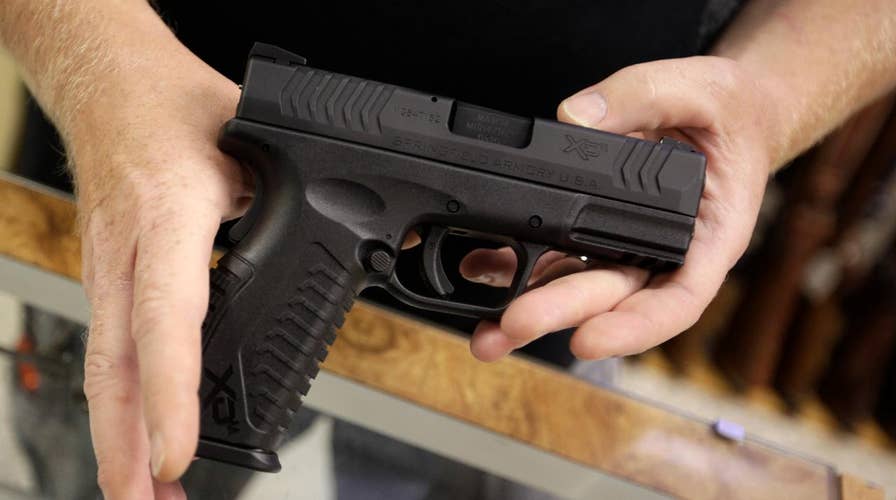Podcast host: I bought my first gun because of CNN town hall
Robert Norman tells Tucker why he believes the debate over gun violence isn't about gun control, but is an ideological battle. #Tucker
The shooting massacre in February at a Florida high school has unleashed a plethora of what experts say are questionable statistics that stoke confusion regarding gun violence in America.
One recent story by CNN, for example, states that there have been 23 school shootings so far this year where someone has been hurt or killed, and 288 since 2009.
“In the recent case by CNN, they made up their own numbers by using a very broad definition of school shooting,” David Katz, CEO of Global Security and a former special agent with the DEA, told Fox News.
In the case of all those school shootings, Katz, who says this sort of study produces a false impression through “deceptive inclusion,” notes CNN’s report includes things such as BB guns. And it’s not necessarily the kind of gun violence that the headlines conjure up. According to Katz, the numbers include any shooting “that just happens to be on school property after hours with no real connection to the type of shootings we are all horrified at.”
William B. Fairley, president of Analysis & Inference — specialists in statistics and data science — agrees that most of the shootings on CNN’s list don’t approximate to what happened in Parkland, Fla., where 17 people were murdered this year in a shooting rampage on Feb. 14 at Marjory Stoneman Douglas High School.
Fairley said that, by his count, 21 of the 23 shootings referenced by CNN “bear little resemblance . . . as they arise out of a fight, robbery, jealousy, accident, domestic situation, etc.” So even though the two school shootings left are two too many, the number 23 can create a misperception.
In addition, there’s a wider picture to take into account. For instance, historical comparisons. As Fairley notes, research has found “the current rate [of gun violence] to be well below that in the 1990s.”
"In the recent case by CNN, they made up their own numbers by using a very broad definition of school shooting.”
Another important comparison: how much gun violence is there in society at large? According to Fairley, “calculations indicate that gun violence in general dwarfs gun violence at schools and universities.” As distressing as school shootings are, Fairley believes we should note that “the injuries and deaths in the 23 incidents reported . . . add up to a tiny fraction of the annual total.”
David Ropeik, a consultant in risk communication and author of “How Risky Is It, Really?” ran the numbers. As he explained in a Washington Post editorial, taking into account the number of students attending school, “the statistical likelihood of any given public school student being murdered by gun, in school, on any given day since 1999, was roughly 1 in 1 billion.”
He then wondered if overreacting to the problem might be more dangerous than the risk of the actual shootings. As Ropeik explained to Fox News, the piece “got a lot of negative feedback . . . but no one quarreled with the numbers themselves.”
Ropeik gives a psychological explanation for the battling statistics on issues like gun safety. With groups like the NRA on one side and gun control advocates on the other, “we subconsciously twist the facts so our view of those facts matches the view of our tribe on that issue . . . People who are selective with how they calculate their numbers, and who are less than open and honest about what went into their numbers, can feed the polarization that keeps society from considering things objectively.”
John Lott, President of the Crime Prevention Research Center and contributor to FoxNews.com, who has published “More Guns, Less Crime,” has long been in the thick of the gun debate. He goes into particulars on school shootings statistics, stating that the incidents under discussion include “a school-bus window broken by a pellet gun, a gun accidentally discharged in a weapons class at a . . . community college, a gun accidentally discharged by a police officer with no one harmed, a college student using a gun [to] stop himself from being beaten.”
Lott thinks the reporting on school shootings isn’t just misleading, but harmful. As he explains, “any death is a tragedy . . . but despite the recent uptick, the number of murders from school shootings has clearly been falling over time since the beginning of the 1990s. It is hard to think of any benefit from exaggerating the risks and making people think that this is a growing problem. It terrorizes kids.”
Experts agree that making the public more aware of the data can help cut through any questionable use of statistics. As Katz claims, the thing “an individual can do is parse through the data and see where terms are being manipulated.”
Ropeik adds, “openness and honesty about how the numbers were compiled should be required, and any numbers that don’t provide that explanation should be treated with caution.”
Lott thinks the press “too readily gives mass news attention to reports from . . . gun control organizations and only fact-checks them weeks after the initial news stories . . . My suggestion is that reporters contact others in the field to get critical comments before they publish news stories, and in this case actually take the time to do independent news searches on these cases themselves.”
Fairley would also demand more from the media that reports these numbers. He notes science journals “have policies for the accurate use of statistics. These are enforced by editors and reviewers to eliminate articles that fail the published standards. Would it be too much to ask that the organs that influence the conduct of our lives meet similar standards?”
Kristine Kotta contributed to this report.







